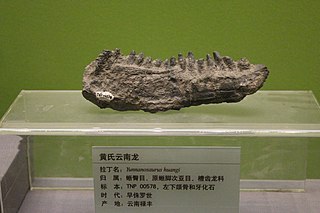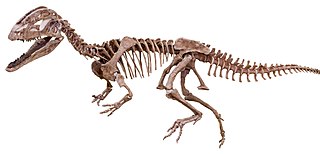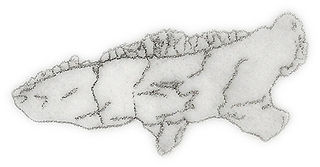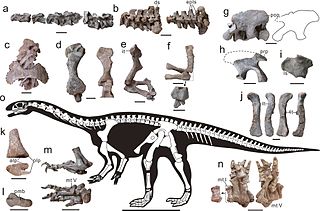Phytosaurs are an extinct group of large, mostly semiaquatic Late Triassic archosauriform reptiles. Phytosaurs belong to the order Phytosauria. and are sometimes referred to as parasuchians. Phytosauria, Parasuchia, Parasuchidae, and Phytosauridae have often been considered equivalent groupings containing the same species. Some recent studies have offered a more nuanced approach, defining Parasuchidae and Phytosauridae as nested clades within Phytosauria as a whole. The clade Phytosauria was defined by Paul Sereno in 2005 as Rutiodon carolinensis and all taxa more closely related to it than to Aetosaurus ferratus, Rauisuchus tiradentes, Prestosuchus chiniquensis, Ornithosuchus woodwardi, or Crocodylus niloticus. Phytosaurs were long-snouted and heavily armoured, bearing a remarkable resemblance to modern crocodilians in size, appearance, and lifestyle, as an example of convergence or parallel evolution.

Therizinosaurs are an extinct group of large herbivorous theropod dinosaurs whose fossils have been mainly discovered from Cretaceous deposits in Asia and North America. Potential fragmentary remains have also been found in Jurassic deposits of Asia and Europe. Various features of the forelimbs, skull and pelvis unite these finds as both theropods and maniraptorans, making them relatives of birds. The name of the representative genus, Therizinosaurus, is derived from the Greek θερίζω and σαῦρος. The older representative, Segnosaurus, is derived from the Latin sēgnis ('slow') and the Greek σαῦρος.

Lufengosaurus is a genus of massospondylid dinosaur which lived during the Early Jurassic period in what is now southwestern China.

Yunnanosaurus is an extinct genus of sauropodomorph dinosaur that lived approximately 199 to 183 million years ago in what is now the Yunnan Province, in China, for which it was named. Yunnanosaurus was a large sized, moderately-built, ground-dwelling, quadrupedal herbivore, that could also walk bipedally, and ranged in size from 7 meters (23 feet) long and 2 m (6.5 ft) high to 4 m (13 ft) high in the largest species.

Sinosaurus is an extinct genus of theropod dinosaur which lived during the Early Jurassic Period. It was a bipedal carnivore similar to Dilophosaurus, with proportionally large limbs to its slender body. Fossils of the animal were found at the Lufeng Formation, in the Yunnan Province of China.

Bienosaurus is a dubious genus of thyreophoran dinosaur from the Lower Jurassic Lower Lufeng Formation in Yunnan Province in China.

Gyposaurus is a genus of basal sauropodomorph dinosaur from the early Jurassic of South Africa. It is usually considered to represent juveniles of other prosauropods, but "G." sinensis is regarded as a possibly valid species.
Dianchungosaurus is an extinct genus of mesoeucrocodylian crocodyliform from the Early Jurassic of China. It was previously considered a dinosaur, but it was recently reclassified as a mesoeucrocodylian by Paul Barrett and Xing Xu (2005). It is probably the same animal as the informally named "Tianchungosaurus". The type species is D. lufengensis and it was described in 1982. A second species, D. elegans, was named in 1986, but it has since become a synonym of the type species.

Tatisaurus is a genus of ornithischian dinosaur from the Early Jurassic from the Lower Lufeng Formation in Yunnan Province in China. Little is known as the remains are fragmentary. The type species is T. oehleri.
Eshanosaurus is a genus of a dinosaur from the early Jurassic Period. It is known only from a fossil partial lower jawbone, found in China. It may be a therizinosaurian, and if so the earliest known coelurosaur.
Fulengia is a dubious genus of basal sauropodomorph dinosaur from the Early Jurassic Lufeng Formation of China.

Lukousaurus is an archosauromorph based on most of a small skull's snout, displaying distinctive lachrymal horns, found in the Early Jurassic-age Lower Lufeng Formation, Yunnan, China and was described by Chung Chien Young in 1940. The generic name refers to the Lugou Bridge, lit. “crossroads”, near Beijing, where the Sino-Japanese War started. L. yini is tentatively classified as a theropod dinosaur by some allied to ceratosaurs, by others a coelurosaur. Its skull is rather robust for its size though the teeth were described by the author as typically theropodan. Whatever Lukousaurus was, it was definitely an archosauromorph.
The Lufeng Formation is a Lower Jurassic sedimentary rock formation found in Yunnan, China. It has two units: the lower Dull Purplish Beds/Shawan Member are of Hettangian age, and Dark Red Beds/Zhangjia'ao Member are of Sinemurian age. It is known for its fossils of early dinosaurs. The Dull Purplish Beds have yielded the possible therizinosaur Eshanosaurus, the possible theropod Lukousaurus, and the "prosauropods" "Gyposaurus" sinensis, Lufengosaurus, Jingshanosaurus, and Yunnanosaurus. Dinosaurs discovered in the Dark Red Beds include the theropod Sinosaurus triassicus, the "prosauropods" "Gyposaurus", Lufengosaurus, and Yunnanosaurus, indeterminate remains of sauropods, and the early armored dinosaurs Bienosaurus and Tatisaurus.
Microchampsa is an extinct genus of protosuchian crocodyliform that existed during the Early Jurassic. Fossils have been found from stratum 6 of the Dahuangtian locality, an outcrop of the Lower Red Beds of the Lufeng Formation in Yunnan, China.

Platyognathus is an extinct genus of protosuchian crocodyliform. Fossils are known from the Early Jurassic Lower Lufeng Formation in Yunnan, China and belong to the type and only species, P. hsui.
Strigosuchus is an extinct genus of crurotarsan from the Early Jurassic of China. Remains have been found from the Lower Lufeng Series in Yunnan. The genus was named by paleontologist D.J. Simmons in 1965 with the type species being S. licinus. Although originally classified as an ornithosuchid, the fragmentary holotype specimen of Strigosuchus has been suggested to be from a sphenosuchian rather than an ornithosuchid. Other Lufeng crocodylomorphs found in association with Strigosuchus include the protosuchian Platyognathus and the sphenosuchian Dibothrosuchus.

Nebulasaurus is an extinct genus of basal eusauropod dinosaur known from the early Middle Jurassic Zhanghe Formation of Yunnan Province, China. It is known only from the holotype braincase LDRC-v.d.1. A phylogenetic analysis found Nebulasaurus to be a sister taxon to Spinophorosaurus from the Middle Jurassic of Africa. This discovery is significant paleontologically because it represents a clade of basal eusauropods previously unknown from Asia.

Xingxiulong is a genus of bipedal sauropodiform from the Early Jurassic of China. It contains a single species, X. chengi, described by Wang et al. in 2017 from three specimens, two adults and an immature individual, that collectively constitute a mostly complete skeleton. Adults of the genus measured 4–5 metres (13–16 ft) long and 1–1.5 metres tall. Phylogenetic analysis suggests that Xingxiulong is most closely related to its contemporary Jingshanosaurus, although an alternative position outside of both the Sauropodiformes and Massospondylidae is also plausible.
Shuangbaisaurus is genus of theropod dinosaur, possibly a junior synonym of Sinosaurus. It lived in the Early Jurassic of Yunnan Province, China, and is represented by a single species, S. anlongbaoensis, known from a partial skull. Like the theropods Dilophosaurus and Sinosaurus,Shuangbaisaurus bore a pair of thin, midline crests on its skull. Unusually, these crests extended backwards over the level of the eyes, which, along with the unusual orientation of the jugal bone, led the describers to name it as a new genus. However, Shuangbaisaurus also possesses a groove between its premaxilla and maxilla, a characteristic which has been used to characterize Sinosaurus as a genus. Among the two morphotypes present within the genus Sinosaurus, Shuangbaisaurus more closely resembles the morphotype that is variably treated as a distinct species, S. sinensis, in its relatively tall skull.

Irisosaurus is an extinct genus of sauropodiform sauropodomorph dinosaur, from the Fengjiahe Formation of China. The type species, Irisosaurus yimenensis was formally described in 2020. It was the sister taxon to Mussaurus.











